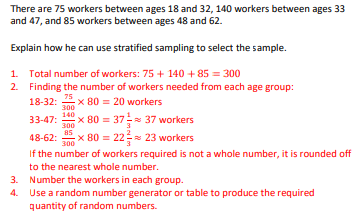Stats chapter 1 - sampling
1/27
There's no tags or description
Looks like no tags are added yet.
Name | Mastery | Learn | Test | Matching | Spaced |
|---|
No study sessions yet.
28 Terms
population
the whole set of items that are of interest
Census
measures/observes every member of a population
Sample
a selection of observations taken from a subset of the population and used to find out more information on the population as a whole
advantages of a census
results should be completely accurate
disadvantages of a census
time consuming and expensive
cannot be used when testing destroys process
hard to process large quantity of data
advantages of sample
less time consuming and cheaper
fewer people have to respond
less data needs to be processed
disadvantages of samples
data may not be accurate
sample may not be large enough to give information about small subgroups of the population
random sampling
where each member of a population has an equal chance of being selected
types of random sampling
simple random sampling
systematic sampling
stratified sampling
simple random sampling
a simple random sample of size n is one where every sample of size n has an equal chance of being selected
Methods of taking a simple random sample
calculator/ random number generator
number each member 1-n. generate random numbers between these intervals to select members
lottery sampling:
write the names of members on identical cards and place them in a hat, draw the cards and select members
systematic sampling
the required elements are chosen at regular intervals from an ordered list
advantages of simple random sampling
free of bias
easy and cheap for small samples and populations
each sampling unit has a known and equal chance of selection
disadvantages of simple random sampling
not suitable for large samples and populations
sampling frame needed
how to take a stystematic sample
e.g. sample size of 20, required from a population of 100
100/20 = 5, so every fifth person is chosen
first person is chosen at random
then increment by 5 each time
advantages of systematic sampling
simple and quick to use
suitable for large samples and large populations
disadvantages of systematic sampling
a sampling frame is needed
bias is introduced if sampling frame is not random
stratified sampling
the population is divided into mutually exclusive strata and a random sample is taken from each
number sampled in a stratum = number in stratum/number in population x overall sample size
example of stratified sampling

advantages of stratified sampling
sample accurately reflects population structure
proportional representation of group within population
disadvantages of stratified sampling
population must be clearly classified into distinct data
same disadvantages as simple random sample within each stratum
types of non-random sampling
quota, opportunity/convenience
quota sampling
an interviewer or researcher selects a sample that reflects the characteristics of the whole population
advantages of quota sampling
allows a small sample to still be representative of the population
no sampling frame required
quick, easy and inexpensive
easy comparison between different groups within a population
disadvantages of quota sampling
non-random sampling can introduce bias
population must be divided into groups, which can be costly or inaccurate
increasing scope of study increases number of groups, which adds time and expenses
non-responses not recorded
opportunity sampling
sample is taken from people who are available at the time of study and who fits the criteria you are looking for
advantages of opportunity sampling
easy and inexpensive
disadvantages of opportunity sampling
unlikely to provide a representative result
highly dependent on individual researcher